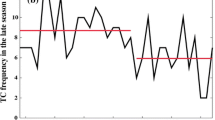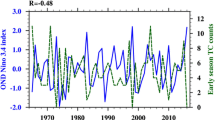Abstract
Relationship between the Antarctic oscillation (AAO) and the western North Pacific typhoon number (WNPTN) in the interannual variability is examined in this research. The WNPTN is correlated with the AAO in June–July–August–September (JJAS) in 1949–1998 at −0.48 for the detrended time series, statistically significant at 99% level. The tropical atmospheric circulation as well as the sea surface temperature variability over the western Pacific associated with AAO has been analyzed. It follows that a positive phase of JJAS AAO corresponds to the larger magnitude of the vertical zonal wind shear, the anomalous low-lever anti-cyclonic circulation and anomalous high-level cyclonic circulation, and lower sea surface temperature in the major typhoon genesis region in the western North Pacific, thus providing unfavorable environment for the typhoon genesis, and vice versa.
Similar content being viewed by others
References
Chan J C L. Interannual and interdecadal variations of tropical cyclone activity over the western North Pacific. Meteor Atmos Phys, 2005, 89: 143–152
Camargo S J, Sobel A H. Western North Pacific Tropical Cyclone Intensity and ENSO. J Climate, 2005, 18(15): 2996–3006
Chan J C L. Tropical cyclone activity in the Northwest Pacific in relation to the El Niño/Southern Oscillation phenomenon. Mon Wea Rev, 1985, 113(4): 599–606
Chan J C L. Tropical cyclone activity in the Western North Pacific in relation to the Stratospheric Quasi-Biennial Oscillation. Mon Wea Rev, 1995, 123(8): 2567–2571
Chia H H, Ropelewski C F. The interannual variability in the genesis location of tropical cyclones in the Northwest Pacific. J Climate, 2002, 15(20): 2934–2944
Lander M A. An exploratory analysis of the relationship between tropical storm formation in the Western North Pacific and ENSO. Mon Wea Rev, 1994, 122(4): 636–651
Wu M C, Chang W L, Leung W M. Impacts of El Niño-Southern Oscillation events on tropical cyclone Landfalling activity in the Western North Pacific. J Climate, 2004, 17(6): 1419–1428
Wang B, Chan J C L. How Strong ENSO events affect tropical storm activity over the Western North Pacific. J Climate, 2002, 15(13): 1643–1658
Gray W M. Atlantic seasonal hurricane frequency: Part I: El Niño and 30 mb quasi-biennial oscillation influences. Mon Wea Rev, 1984, 112(9), 1649–1668
Jones C G, Thorncroft C D. The role of El Niño in Atlantic tropical cyclone activity. Weather, 1998, 53: 324–336
Saunders M A, Chandler R E, Merchant C J, et al. Atlantic hurricanes and NW Pacific typhoons ENSO spatial impacts on occurrence and landfall. Geophys Res Lett, 2000, 27(8): 1147–1150, doi:10.1029/1999GL010948
Thompson D W J, Lorenz D J. The signature of the annular modes in the tropical troposphere. J Climate, 2004, 17(22): 4330–4342
Wang H J, Fan K. Central-north China precipitation as reconstructed from the Qing dynasty: Signal of the Antarctic Atmospheric Oscillation. Geophys Res Lett, 2005, 32: L24705, doi:10.1029/2005GL024562
Gong D Y, Wang S W. Definition of Antarctic Oscillation index. Geophys Res Lett, 1999, 26(4): 459–462
Thompson D W J, Wallace J M. Annular modes in the extratropical circulation: Part I: month-to-month variability. J Climate, 2000, 13(5): 1000–1016
Jarvinen B R, Neumann C J, Davis M A S. A tropical cyclone data tape for the North Atlantic Basin, 1886–1983: Contents, limitations, and uses. NOAA Technical Memorandum NWS NHC 22, Coral Gables, Florida, 1984
Landsea C W, Anderson C, Charles N, et al. The Atlantic hurricane database re-analysis project: Documentation for the 1851–1910 alterations and additions to the HURDAT database. In: Murname R J, Liu K B, eds. Hurricanes and Typhoons: Past, Present and Future. New York: Columbia University Press, 2004. 177–221
Basnett T A, Parker D E. Development of the Global Mean Sea Level Pressure Data Set GMSLP2. Hadley Centre Climate Research Technical Note CRTN 79, 1997
Kalnay E, et al. The NCEP/NCAR 40-year reanalyses project. Bull Am Meteorol Soc, 1996, 77(3): 437–471
Reynolds R W, Rayner N A, Smith T M, et al. An improved in situ and satellite SST analysis for climate. J Climate, 2002, 15(13): 1609–1625
Gray W M. Global guide of the origin of tropical disturbances and storms. Mon Wea Rev, 1968, 96(10): 669–700
Furevik T, Bentsen M, Drange H, et al. Description and validation of the Bergen Climate Model: ARPEGE coupled with MICOM. Climate Dynamics, 2003, 21(1): 27–51
Nitta T. Convective activities in tropical western Pacific and their impact on the Northern Hemisphere summer circulation. J Meteor Soc Japan, 1987, 65(3): 373–390
Author information
Authors and Affiliations
Corresponding author
Additional information
Supported by the National Natural Science Foundation of China (Grant Nos. 40631005 and 40620130113), and CAS International Partnership Project
About this article
Cite this article
Wang, H., Fan, K. Relationship between the Antarctic oscillation in the western North Pacific typhoon frequency. CHINESE SCI BULL 52, 561–565 (2007). https://doi.org/10.1007/s11434-007-0040-4
Received:
Accepted:
Issue Date:
DOI: https://doi.org/10.1007/s11434-007-0040-4




